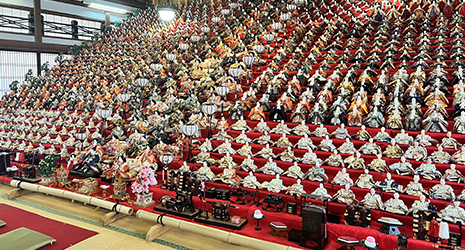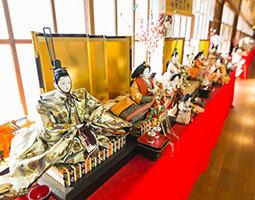March 2022
- English
- 日本語
The Kasuisai Hina Matsuri Doll Festival

Approximately 1,200 dolls on 32 tiers decorating the Zuiryukaku reception hall on the grounds of Kasuisai Temple 
Emperor and Empress dolls Odairi-sama and Ohina-sama

Dolls decorating the stairs to the Zuiryukaku reception hall 
Dolls decorating a hallway during the Kasuisai Hina Matsuri

The annual Hina Matsuri (Doll Festival) is held from January through March at Kasuisai, an ancient temple with about 620 years of history in Fukuroi City, Shizuoka Prefecture. At this time, the temple is decorated with about 1,200 dolls on a doll stand with 32 tiers—the largest such display in Japan. It is said that this stunning scene also embodies a sense of gratitude to the dolls themselves.

The Hina Matsuri, held on March 3, is familiar to Japanese people as a traditional event where they pray for the healthy growth and happiness of young girls. As the day of the festival approaches, families with young girls will decorate their homes with festival dolls, typically called Odairi-sama and Ohina-sama (emperor and empress dolls). Other customs include celebrating by offering peach blossoms, sweet white sake and rhombus-shaped rice cakes, and eating special chirashi-zushi* and hamaguri (a type of clam) soup. In the ancient Japanese lunar calendar, the festival was held when peach blossoms were blooming, so the festival is also called the Momo no Sekku (Peach Festival) and it is an event that ushers in the arrival of spring.
There are various theories as to the Hina Matsuri’s origins, but one states that it began from a custom in the Heian period (late eighth to late twelfth century) of creating dolls with paper or plants, sending one’s illness or misfortune to the doll by patting one’s body with the doll, and sending the doll down the river as a sacrifice. That is why it became taboo to pass a doll on from parent to child or to share a doll among sisters as it would pass on and share misfortune. Once a girl safely came of age, many of the dolls, who’s duty had ended, would be taken by the Buddhist temple and commemorated.

Akihasohonden Kasuisai Temple is an ancient Buddhist temple founded in 1401 in Fukuroi City, Shizuoka Prefecture, with many buildings on an approximately 33-hectare compound. This temple receives dolls from all over Japan that have served their purpose.
Oota Syobun of Kasuisai Temple says that “even today, there are about 300 to 400 requests each year to commemorate the dolls that have watched over children for many years and have acted as a substitute for misfortunes. People at the temple offer sutras, give thanks, and burn the dolls that are received. Of these dolls that have been cared for at home, many are still in good condition. So we started holding the annual Kasuisai Hina Matsuri in 2015 to properly display and commemorate the dolls before burning them. I hope this festival conveys a sense of gratitude towards the dolls and a sense of taking good care of things.”

The Kasuisai Hina Matsuri is held from January 1 to March 31 each year. The main attraction is the approximately 1,200 dolls on 32 tiers decorating the large hall on the second floor of Zuiryukaku, a two-story reception hall built from cypress that is also designated by the national government as a Tangible Cultural Property. In addition to the display in the large hall, there are splendid dolls decorating the hallways and other parts of the building. On some days, the 50 or so stairs outside are also decorated, and the whole temple grounds feel gorgeous. In March, the month of the festival, approximately 20 varieties of peonies in 70 pots bloom in the indoor peony garden on the first floor of Zuiryukaku, decorating the event with flowers.
Oota says, “The dolls in the large hall are placed so that visitors can fully see each of their faces. Many people are moved not just by the number of dolls, but by the beauty of some 1,200 dolls neatly arranged.” In Fukuroi City, the City-wide Hina Matsuri Project is held to coincide with the Kasuisai Hina Matsuri, with dolls decorating stores, offices and facilities, and the whole region becoming a part of the Hina Matsuri.
The dolls displayed at Kasuisai Temple reflect both the beauty of the dolls themselves, and people’s feelings of gratitude towards them.
* Chirashi-zushi is sushi rice topped, or “scattered,” with seafood and other ingredients.

